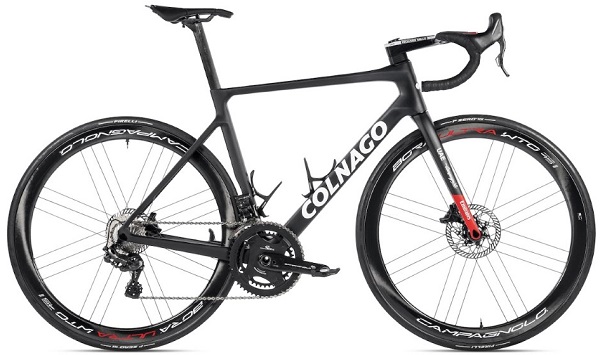
New Colnago Prototipo Photo and tech
Read also:
2022 Eurobike FRANKFURT all 2023 bicycles bikes news info photo rumors review
2022 EICMA MILAN all 2023 bicycles bikes news info photo rumors review
All 2023 bicycles bikes news info photo rumors review preview
All 2023 racing bikes news info photo rumors review preview
All 2023 mtb mountain bikes news info photo rumors review preview
All 2023 gravel bikes news info photo rumors review preview
All 2023 e-bike news info photo rumors review preview
We predicted that one of Colnago's innovations for 2023 could be a new racing bike with a carbon fiber monocoque frame that would replace the current Colnago V3rs.
Here the official statement of Colnago:
Starting this weekend, UAE Team Emirates riders will be able to use a new bike option in the race: the Colnago Prototipo. In addition to the V3Rs, therefore, some of them will consider it appropriate and according to their technical needs, they will be able to ride with this bike still under development before being marketed.
The project was developed with a completely new method. In a first phase, the rigidity characteristics of the Prototype, monocoque frame, were tested by Colnago on the parts that make up the new chassis of the C series, made up of modular and non-monocoque parts. Being able to work on parts of a frame instead of a complete frame, as it should happen for the monocoque, gave Colnago the possibility to study different laminations of the carbon tubes with a much more agile and verifiable sequence in a short time.
After the various tests, five stiffness matrices were selected and therefore five “test” laminations were reported for the monocoque frames to work on in the field, corresponding to five different versions that will be available to the team in competitions starting from tomorrow. From these five different laminations it will be necessary to gradually arrive at one, the definitive version that will be marketed in the future. The only way to have perfect and clean feedback is to make real “race-ready” bikes available to our riders and make them use them as hard as possible, ie during competitions.
Davide Fumagalli, Colnago R&D manager, explained: “To improve the performance of this frame we used a totally new method, that is to collaborate directly with the UAE Team Emirates athletes, proposing to use frames produced with different carbon laminations from time to time. The ultimate goal is to achieve the best lamination for a frame that must be as versatile as possible, suited to the needs of sprinters, walkers and climbers and to be at the height in the different stages of the race. On the other hand, computer and wind tunnel tests are important, but they always have limitations: it is in fact difficult - if not impossible - to replicate the racing contexts, the irregularities of the course, the stresses of the terrain, the aerodynamic turbulence, the accelerations in the different moments of the competition. At the point of development we have reached, it is becoming increasingly difficult to achieve improvements. In this way, that is, by also taking advantage of the experience of those who ride their bicycles for many hours a day, we think we can make our racing bikes take a further and important step forward ".
From a design point of view, the key points in the development of the Colnago Prototipo are above all the thin and hollowed head tube with deep and marked veins, in addition to the larger and more robust bottom bracket area. A work done with method, aimed at combining the technical results with the aesthetic ones. In fact, in Colnago we firmly believe that product design and engineering must go hand in hand, for this reason in the development of the Prototype we have involved one of the greatest cycling designers, the Norwegian Torgny Fjeldskaar, who has designed some of the most iconic bike models. of the last twenty years with a long experience also in the world of automotive and industrial design.
The latter said: "First of all I would like to say that I am very proud to be able to collaborate with one of the most important brands in the world of cycling. The starting point in the development of the Prototype was to create a totally performance-driven frame, that is, with a design clearly oriented towards obtaining the best technical performance. The objectives we set ourselves with Davide and his team and on which we worked were to obtain greater rigidity towards the stresses generated by pedaling and a lower aerodynamic drag against an overall weight of the frame substantially unchanged if compared to that of the V3Rs. I think the most important work was to improve aerodynamics through a new head tube design, which also improved stiffness, making it even more responsive. "
